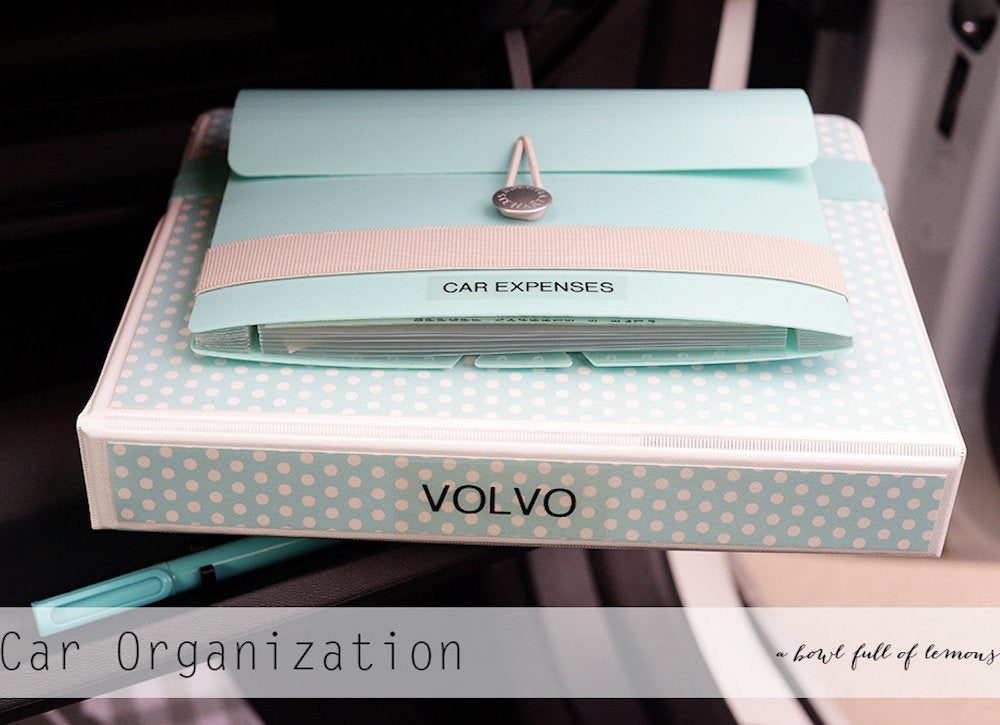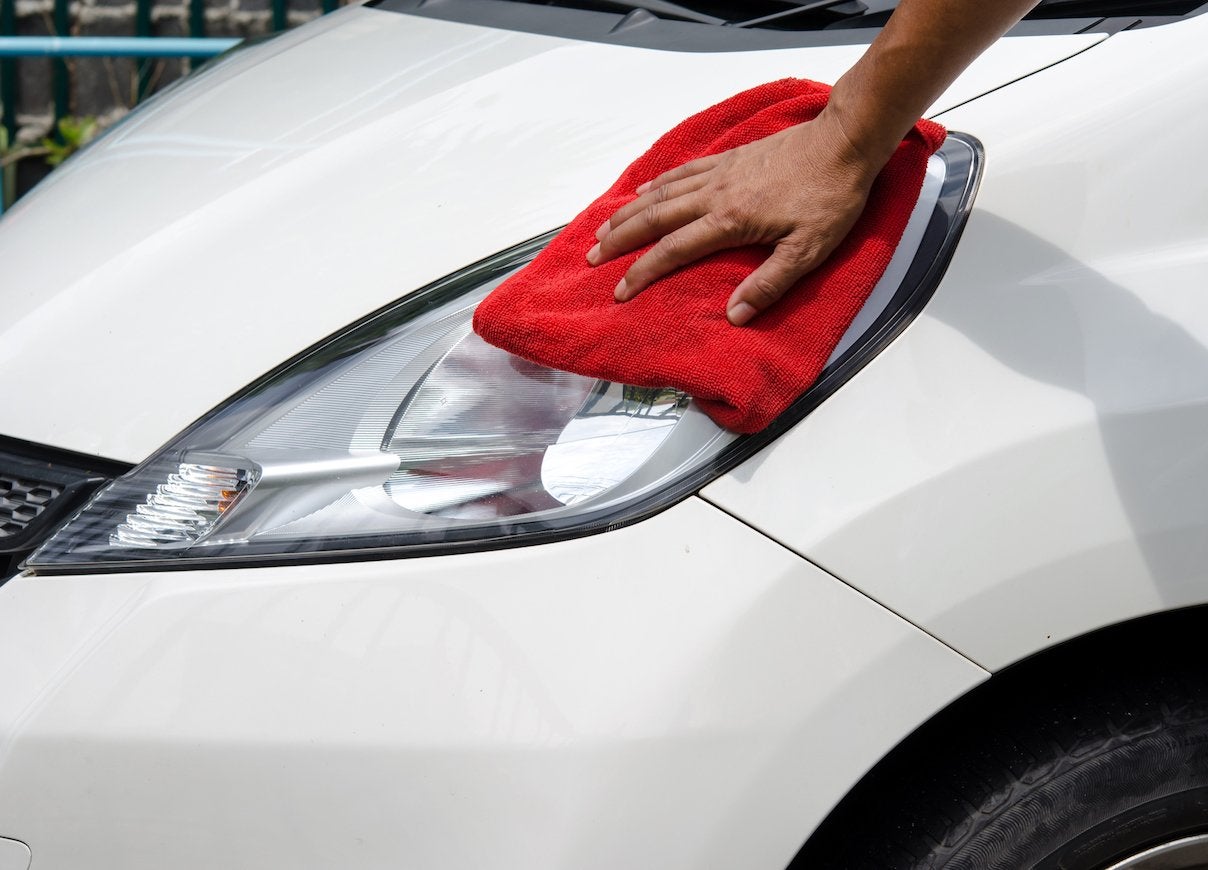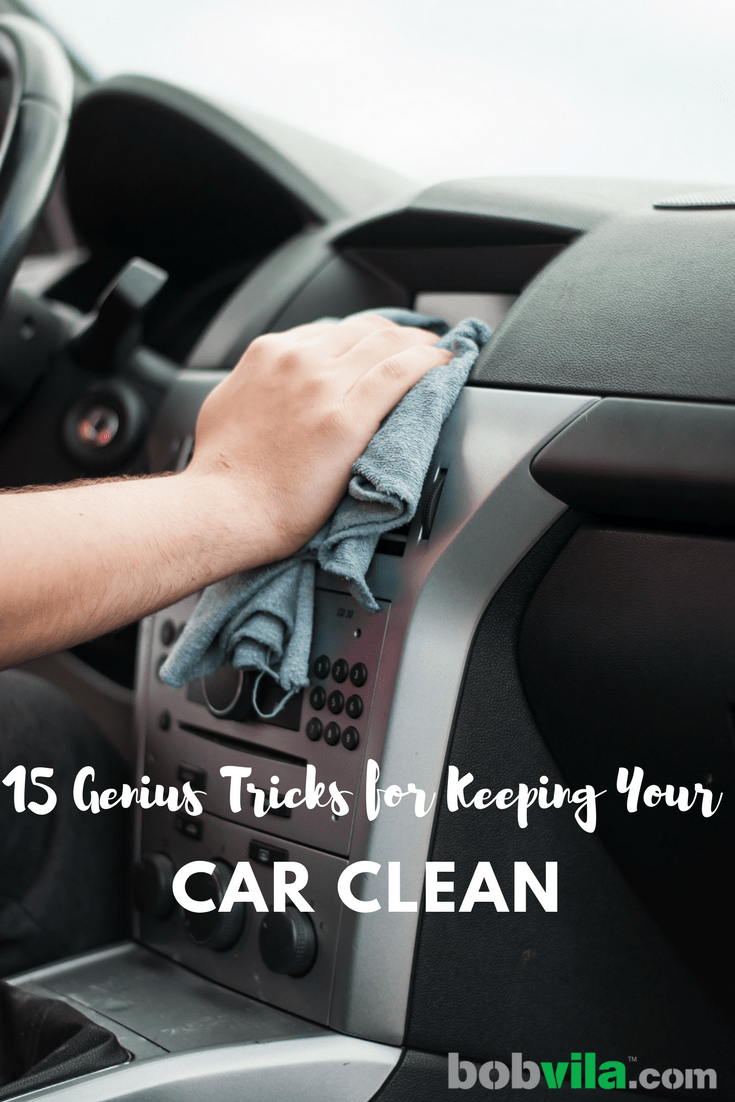We may earn revenue from the products available on this page and participate in affiliate programs. Learn More ›
Organize the Family Car

If you have kids, you have car clutter. Books, toys, snacks, jackets—these things seem to multiply overnight and take on a life of their own. Get kid-clutter under control with a lidded basket large enough to hold all the necessities as well as those last-minute additions that always seem to come along for the ride.
Related: 25 DIY Storage Ideas to Help Corral Your Kids’ Clutter
Keep the Cup Holders Clean

Yuck! Spills, drips, and grime tend to build up on the bottom of your car’s cup holders. But who wants to spend time scrubbing away the sticky mess? Instead, take a tip from One Good Thing, and fill the cup holders with inexpensive silicone cupcake liners. When the inevitable spill happens, just toss the cupcake liner into the dishwasher.
File It

If your car breaks down or you’re pulled over for a traffic infraction, the last thing you need is the additional stress of a frantic search for your mechanic’s phone number or your auto registration and insurance documents. Instead, gather all your important car information together in a small binder, then stash it in the glove compartment.
Contain the Trash

Road trips can be fun, but they’re often accompanied by a gradually accumulating pile of food wrappers and empty cups. Don’t let your kids drop trash on the car floor; instead, corral it in this handy cereal container turned trash can, the brainchild of Unsophisticook. It couldn’t be easier: Just take a plastic cereal storage container, line it with a small plastic trash bag, and voilà! A place for trash other than the back seat.
Related: Best Car Accessories: 19 Gadgets Your Ride Really Needs
Clean the Floor Mats

Typically, your car’s floor mats are the filthiest spot in your ride. Mud, crumbs, bits of paper, and leaves all tend to accumulate beneath your feet, but vacuuming and scrubbing the mats admittedly isn’t the most enjoyable use of your precious free time. One Crazy House has a better idea: Just give the mats a good shake, then pop them right into your dishwasher for a thorough cleaning. Your car looks better already.
Related: Over a Dozen Things You Didn’t Know You Could Clean in the Dishwasher
Corral Spare Change

When it’s time to feed a parking meter or pay a toll, don’t waste time rooting through your purse or pockets. Instead, copy this smart trick from Kalyn Brooke, and store loose change in a small, round plastic chewing gum container—you can find one at any supermarket checkout line. Set the container in your car’s front cup holder, and you’ll always have coins at hand when you need them.
DIY Pop-Up Trunk Shelf

Wish you could magically double your trunk space when it’s time to tote home the spoils of a major shopping trip? Well, now you can, with the ingenious and not-too-difficult DIY pop-up trunk shelf from Instructables. Not only is it perfect for groceries, but it’s also a great way to hide valuables, store gym shoes or sporting equipment, or protect just-purchased nursery plants from heavy bags of soil or fertilizer.
Related: 16 Ingenious IKEA Hacks
Gather Up the Small Stuff

If you spend a lot of time on the road with your kids, you’re familiar with the constant requests for the phone or iPod charger, a Band-Aid, a hair scrunchie, or any of a multitude of other small items. Make it easy to find these things by converting a few travel-size plastic Q-tips holders into car organizers. Toss the mini organizers into the glove compartment, the car console, or your back-seat auto-organizer basket. (You do have one, right?)
Just Hold Everything

Have you ever wished you had a central supply station inside your car? Blogger Angela of blue I style did, so she came up with this easy and smart idea. Convert a multidrawered plastic crafts box into a storage spot for just about anything your family is likely to need on a car trip, like sunscreen, a first aid kit, snacks, wet wipes, and similar items. Now you’re organized!
DIY Car Freshener

If that new car smell vanished long ago, and your auto now carries the aroma of old French fries, dog hair, and sweaty soccer uniforms, it’s time to bring the freshness back to your ride. Don’t worry, there’s no need to spring for any of those artificial, unpleasant, and sometimes headache-inducing fragrances. With the easy directions at Lemons, Lavender & Laundry, you can quickly create your own car freshener out of your favorite essential oils and a wooden ornament.
Related: 11 Super Simple Ways to Make Your House Smell Fresh
Clean the Headlights

If your car’s headlights aren’t brightening your path as much as they used to, or if they look dim, yellow, and foggy, it’s time to break out the toothpaste. Yes, the same minty-fresh paste that whitens your choppers can also restore the plastic cover over a car’s headlights to its former clear, shiny glory. Just spread toothpaste on a rag, rub the headlight until all the grunge is gone, and then rinse with clean water. Ta-da!
Polish Your Car’s Interior

Dashboard looking dusty? Pleather or leather seats lost their luster? Armrests looking a bit worse for wear? You’ll find the remedy in your kitchen pantry—coffee filters and olive oil. Just pour a few drops of the oil onto a coffee filter, then wipe your car’s interior to remove built-up dust, grime, and doggy nose smudges. Your ride will look almost like new.
Related: 20 Uses for Coffee Filters You Have to See to Believe
Keep Groceries Upright in the Trunk

Oh no! You turned a corner too quickly, and now eggs, oranges, and canned vegetables have escaped the grocery bags and are rolling around the trunk. This common scenario has a simple solution—just slip a bungee cord through the handles of your grocery bags, then stretch the cord across the trunk and fasten it on each side. No more grocery tumbles.
Related: 11 Unusual Uses for a Bungee Cord
Get Rid of Stickers

The election is long over; now, only the bumper sticker remains. Trying to strip the sticker away with your fingernails will probably just leave you with a stubborn mess. Instead, get your blow dryer in on the action. Select the hottest temperature, then focus the blast of air on the bumper sticker. It might take a minute or two, but the heat should soften the sticker’s glue enough to let you easily peel the paper off the bumper.
Related: 12 Clever Uses for a Hair Dryer That Will Blow You Away
Restore the Dashboard

If your car’s dashboard is showing its age with small cracks or dullness, head to the medicine cabinet for the solution: Vaseline. This petroleum jelly is an easy way to bring back the shine to your dashboard, but don’t go overboard. First, use a clean, damp rag to wash away dust, then dry thoroughly. Then, using a dry rag, wipe a very thin layer of Vaseline across the dashboard. Finally, use the cloth to smooth away any excess. Done!
Control the Car Clutter

These clever ideas will make cleanup a breeze and help you organize the necessary things to keep in your car—like emergency kits and important forms—so you always know where to find them.

Everything You Need for a Lush and Healthy Lawn
Keeping your grass green and your plants thriving doesn’t just take a green thumb—it starts with the right tools and supplies.
